Guide to Solar Cable Management Solutions: Best Ties and Clips
August 1, 2025
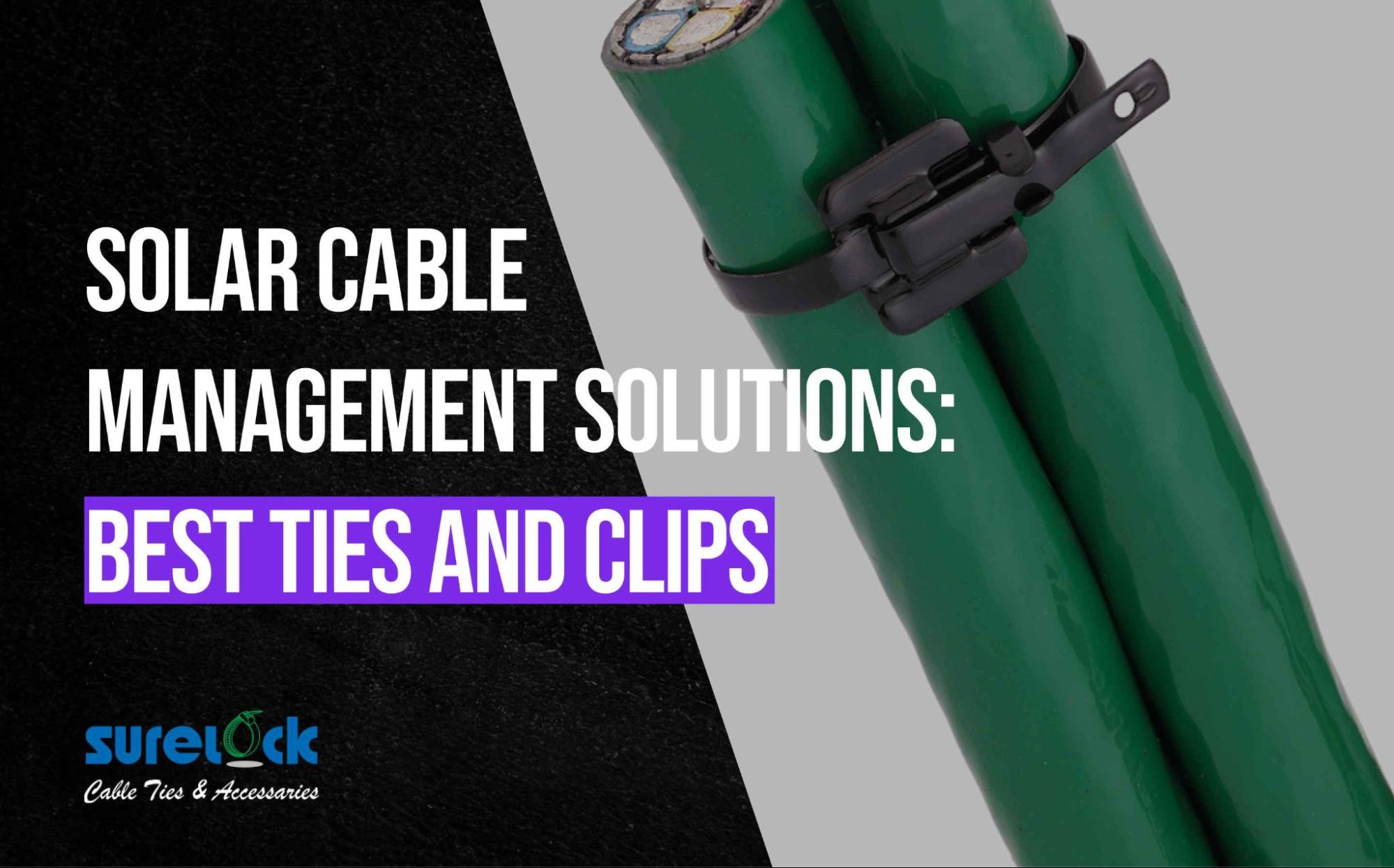
Are your solar cables leaving your system vulnerable to damage and efficiency loss? Proper cable management is often overlooked, yet it’s essential for protecting cables from harsh weather and mechanical stress while maintaining safety and efficiency.
When cables are well-organized and secured, they reduce risks like fire hazards and wear, which helps preserve energy output and extend the system’s lifespan. Choosing the right cable management solutions also simplifies maintenance and inspections, making your solar setup more reliable.
This blog explains the basics of solar cable management and why it matters. You’ll also explore the various types of solar cable management solutions, how to choose the right one, and essential best practices for optimal performance. It will help you protect your investment, maximize performance, and ensure long-term reliability in solar installations.
What Is Solar Cable Management?
Solar cable management involves organizing, routing, and securing the cables connecting solar panels to critical components like inverters and junction boxes. Effective cable management protects cables from environmental stresses such as UV exposure, moisture, wind, and temperature fluctuations.
Properly secured cables help prevent damage and avoid electrical issues, enhancing system reliability and safety. Additionally, organized cables simplify routine inspections and maintenance, improving long-term efficiency and performance of solar installations.
Now that we understand solar cable management, let’s explore why it’s so important.
Why Proper Cable Management Matters?
Proper cable management plays a critical role in the success of any solar installation. It safeguards the integrity of cables, supports system performance, and reduces potential risks.
Key reasons why cable management matters:
- Prevents electrical faults and system downtime.
- Protects cables from environmental damage like UV rays, moisture, and temperature changes.
- Reduces fire hazards and tripping risks, improving site safety.
- Maintains consistent energy output by avoiding cable wear and failures.
- Extends the lifespan of cables and the overall solar system.
- Simplifies inspections, maintenance, and troubleshooting.
- Supports regulatory compliance and industry standards.
- Lowers long-term operational and repair costs.
With the importance clear, let’s look at key methods for managing solar plant cables effectively.
Also read: Top Zip Ties for All Uses: Selection and Buying Guide
Key Methods for Managing Solar Plant Cables
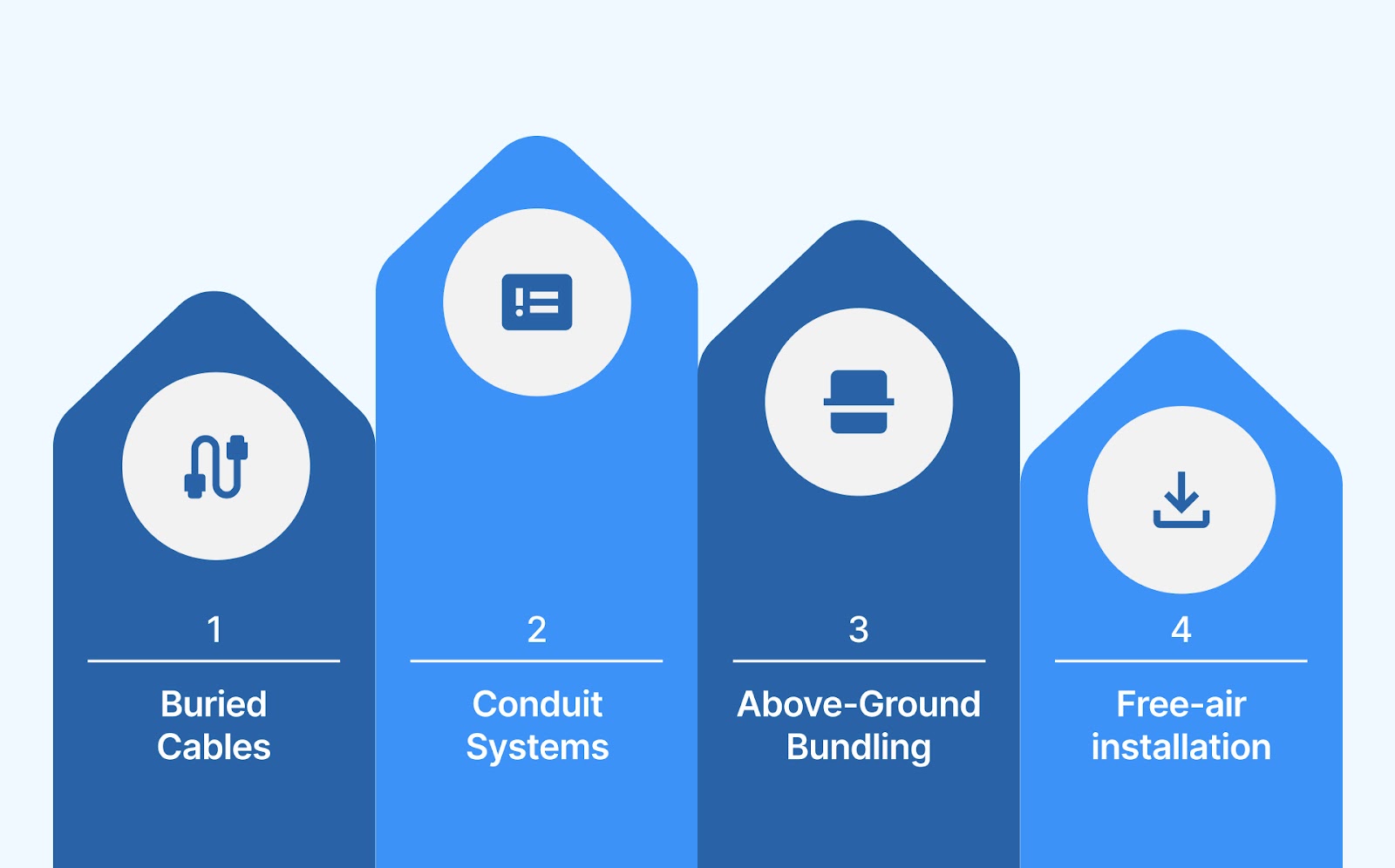
Managing cables in solar plants requires solutions that balance protection, accessibility, and efficiency. The choice of method depends on site conditions, installation scale, and maintenance needs.
Common solar cable management options include:
- Buried Cables: Installed underground, offering protection but requiring trenching and higher repair costs. Heat buildup can reduce cable efficiency.
- Conduit Systems: Cables run through protective pipes, shielding them from moisture and pressure. This eases repairs but can trap heat, affecting performance.
- Above-Ground Bundling: Cables are grouped and supported above ground, simplifying access and repairs while reducing installation time. Some heat-related efficiency loss may occur.
- Free-air installation: Cables run openly with spacers to allow airflow, reducing heat buildup and maintaining performance. This method is cost-effective and simplifies maintenance.
Each method offers trade-offs between protection, cost, and ease of maintenance. Selecting the right approach ensures system reliability and longevity. For best results, trust Surelock’s durable cable ties and accessories designed to withstand harsh solar environments.
Having covered the methods, we’ll review the types of solar cable management solutions that are available next.
Types of Solar Cable Management Solutions
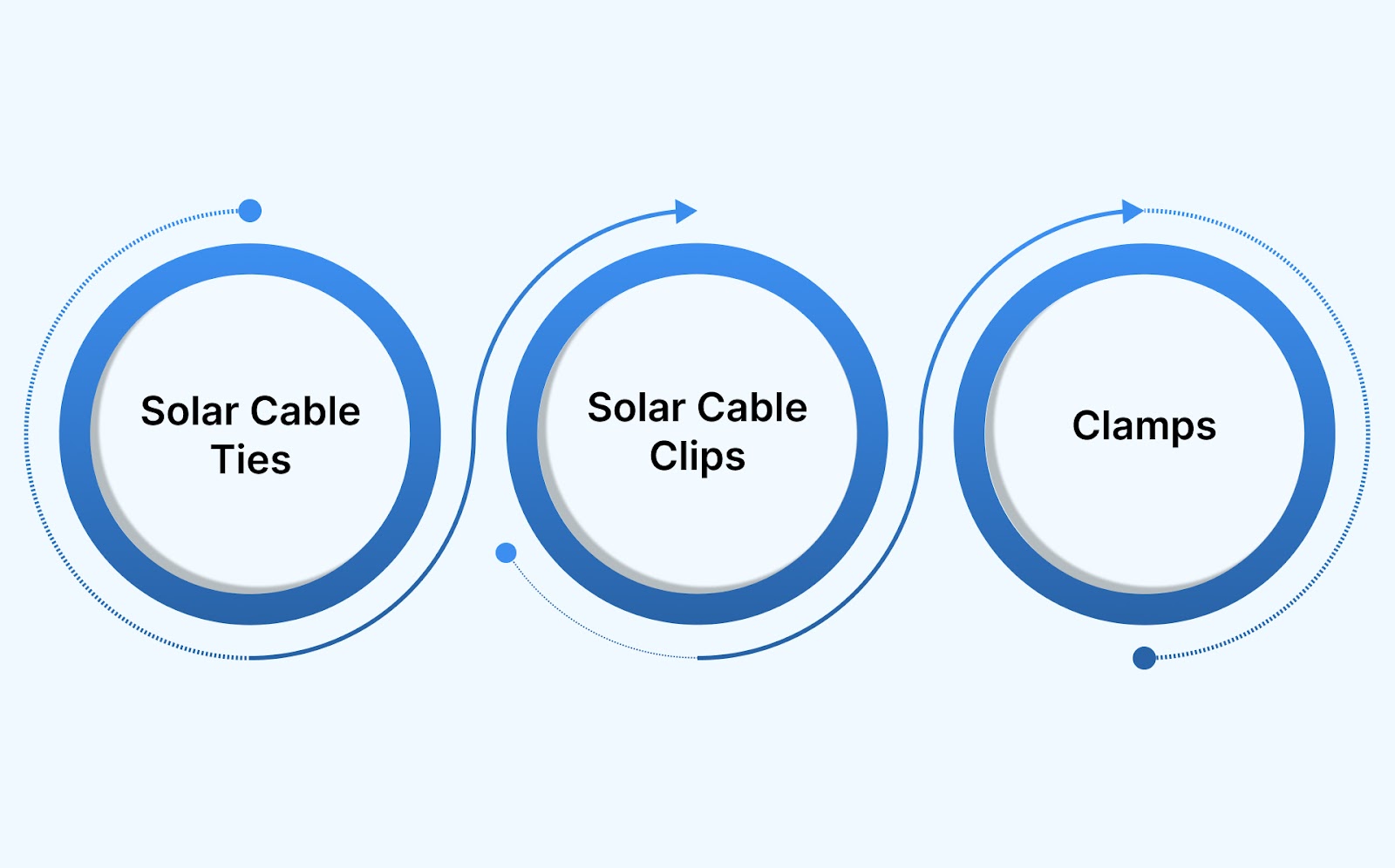
Effective solar cable management relies on using the right solutions to organize, secure, and protect cables throughout the system. Different options offer varying benefits depending on the installation’s needs, environment, and budget. Below are the key types of solar cable management solutions commonly used.
Solar Cable Ties
Solar cable ties are flexible, strap-like fasteners designed to bundle and secure cables quickly and efficiently. Their simple design makes them ideal for managing cables in both small and large solar installations. Let’s explore their pros and cons:
Pros:
- Easy to install and use
- Cost-effective for large-scale applications
- Available in UV-resistant variants for outdoor durability
Cons:
- Mostly single-use and non-reusable
- Risk of overtightening damaging cables
- Environmental impact if not disposed of properly
Solar Cable Clips
Cable clips attach cables directly to solar panel frames or mounting structures, keeping cables secure and preventing movement. They help maintain cable integrity by reducing wear caused by vibration and environmental factors. Here are their pros and cons:
Pros:
- Reusable and repositionable
- Minimize cable wear and damage
- Installation usually requires no drilling, protecting the panels
Cons:
- Higher upfront cost compared to the ties
- May require more installation time depending on the design
Clamps
Clamps secure individual cables or bundles firmly to mounting points, ensuring cables remain fixed under stress or vibration. Typically made from corrosion-resistant materials, clamps are suited for areas that experience mechanical strain or harsh environmental conditions. Let’s take a look at their pros and cons:
Pros:
- Provide robust and reliable cable anchoring
- Often made from corrosion-resistant materials
- Suitable for high-stress or vibration-prone areas
Cons:
- May require tools for installation
- Less adaptable for frequent repositioning
Each option serves a specific role in solar cable management. Choosing the right combination improves system safety, durability, and maintenance ease.
With solution types in mind, it’s time to compare them side by side.
Comparison of Popular Solar Cable Management Solutions
The choice of cable management impacts your solar system’s durability and efficiency. Here’s a detailed comparison of cable ties, clips, and clamps based on key features and applications.
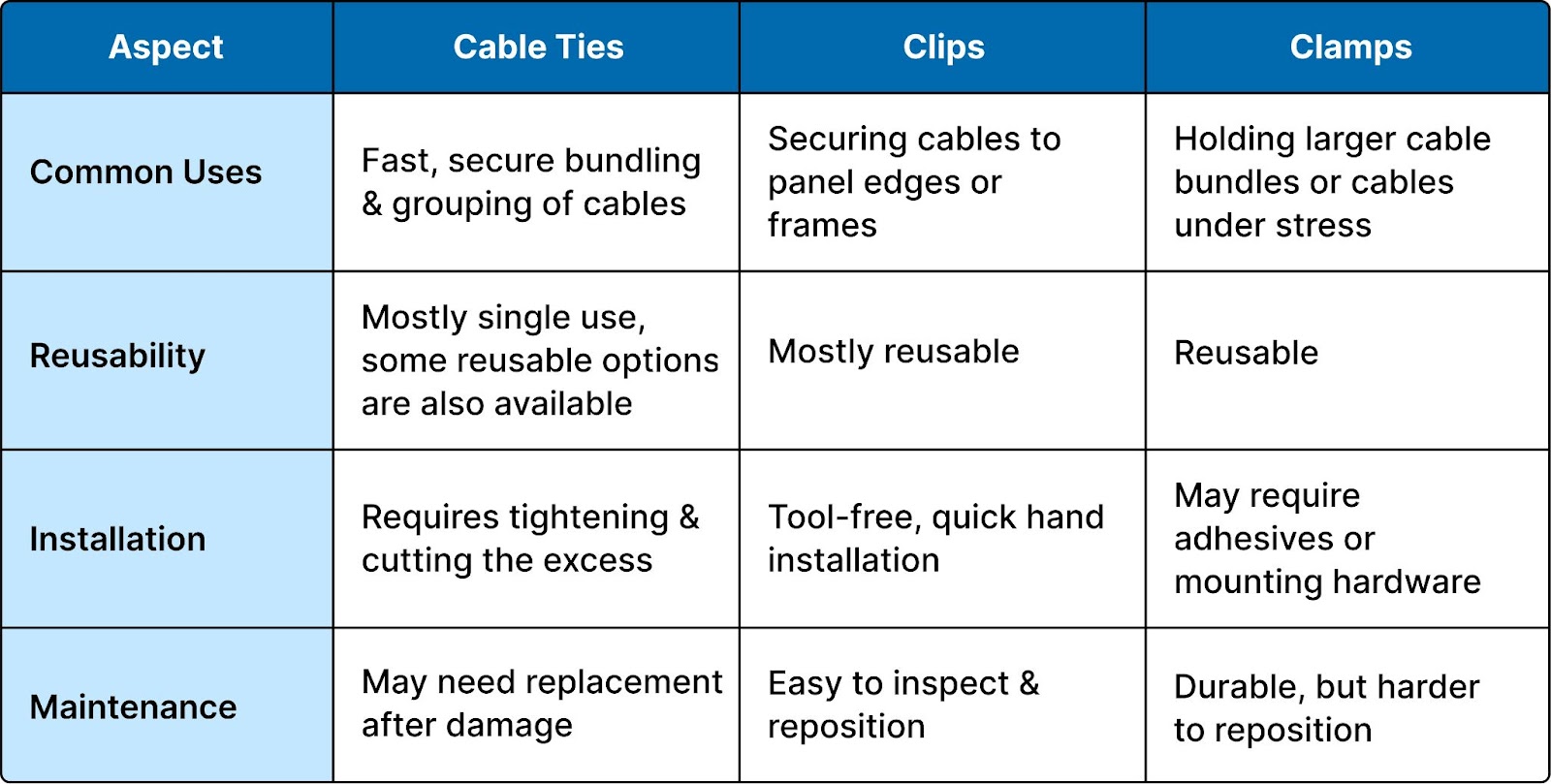
Verdict: Cable ties lead with versatility and ease of use, while clips and clamps excel in protection and reusability. Choosing the right solution depends on the application’s needs, but cable ties remain a core staple in solar cable management. Next, we’ll explore the types of cable ties applicable for solar installations.
Common Cable Ties Applicable for Solar Installations
Cable management is crucial when setting up a solar power system to ensure safety, durability, and efficiency. Various types of cable ties are specifically designed to handle the unique demands of solar installations. Below are the different cable tie types you can use for securing cables in solar systems:
- Non-Releasable Cable Ties: These ties provide an economical and versatile solution for cable bunching. Their self-locking, one-piece construction ensures fast and easy installation. Once locked, they cannot be opened or reused.
- UV Resistant Cable Ties: Designed for outdoor cable bunching applications, these self-locking, non-releasable cable ties offer an economical and versatile solution. Made from UV-resistant nylon, they have an extended lifespan in outdoor conditions.
- Double Loop Tie: Ideal for securing two parallel routing cables, this tie can also be used for packaging bags. It allows for separating bundles with a single cable and can securely hold different-diameter bundles.
- Double Lock Tie: This tie is commonly used for bundling cables. It offers better tensile strength than standard ties, and its outer serrations prevent cable damage. The double locking head ensures a firm grip without slipping.
- Reusable Steel Tie Coated: Perfect for harsh climates, high temperatures, and applications requiring higher tensile strength, these reusable ties have a non-toxic, UV-resistant, and long-lasting coating that is long-lasting in corrosive environments. They can be unfastened and reused.
- Reusable Steel Tie Uncoated: Similar to the coated version, these reusable steel ties are ideal for harsh conditions and can be unfastened. Their smooth edges ensure safety during installation.
- Easy Lock Steel Tie Coated: These self-locking steel ties offer multiple locking systems, ensuring a fast, secure installation. Their coating is non-toxic, UV resistant, and designed to withstand corrosive environments, providing long-term durability.
- Easy Lock Steel Tie Uncoated: Offering the same self-locking functionality as the coated version, these ties provide a secure installation without coating and have smooth edges for safe handling.
- Multi Lock Steel Tie Coated: Designed for applications requiring higher tensile strength, these self-locking ties provide a strong and secure hold with a coating that is non-toxic, halogen-free, and UV resistant, suitable for corrosive climates.
- Multi Lock Steel Tie Uncoated: Similar to the coated multi-lock tie, this uncoated version provides a strong grip and can accommodate double wraps. Smooth edges ensure safety during installation.
- Ball Lock Steel Tie Coated: These self-locking steel ties are easy to install and provide positive locking through a ball inside the angled ramp of the head. They are designed for corrosive climates and have a coating that offers UV resistance and long-term durability.
- Ball Lock Steel Tie Partly Coated: Offering similar features to the coated version, these ties are partly coated for extra protection. They are self-locking and fast to install, providing strong and secure bundling in harsh environments.
- Ball Lock Steel Tie Uncoated: These uncoated ball lock ties are designed for easy installation and positive locking, with smooth edges for safety during installation. They are ideal for applications in corrosive environments.
- Ball Lock Zigzag Tie Coated: Specifically used in applications with extensive vibration, these ties provide a positive locking mechanism and a modified waveform clamp for superior tension retention. Their coating is non-toxic and UV resistant, ideal for corrosive environments.
- Ball Lock Zigzag Tie Uncoated: Like the coated version, these uncoated ties are designed for areas with high vibration. They offer a strong grip with smooth edges for safe installation.
- Reusable Economy Steel Tie Coated: These ties are designed for low-cost, low-tensile applications in corrosive and high-temperature environments. The coating provides long-term resistance to UV and harsh climates while ensuring safe installation with smooth edges.
- Reusable Economy Steel Tie Uncoated: Similar to the coated economy steel tie, this uncoated version is suitable for low-cost applications where tensile strength is less of a concern. It provides safety during installation with smooth edges.
Surelock offers a wide range of durable, UV-resistant cable ties, top-notch clips, and clamps engineered to meet the demanding conditions of various industries. Our products help you secure cables efficiently and reliably.
After comparing options, let’s focus on choosing the right solution for your specific needs.
Choosing the Right Solar Cable Management Solution for Your Needs
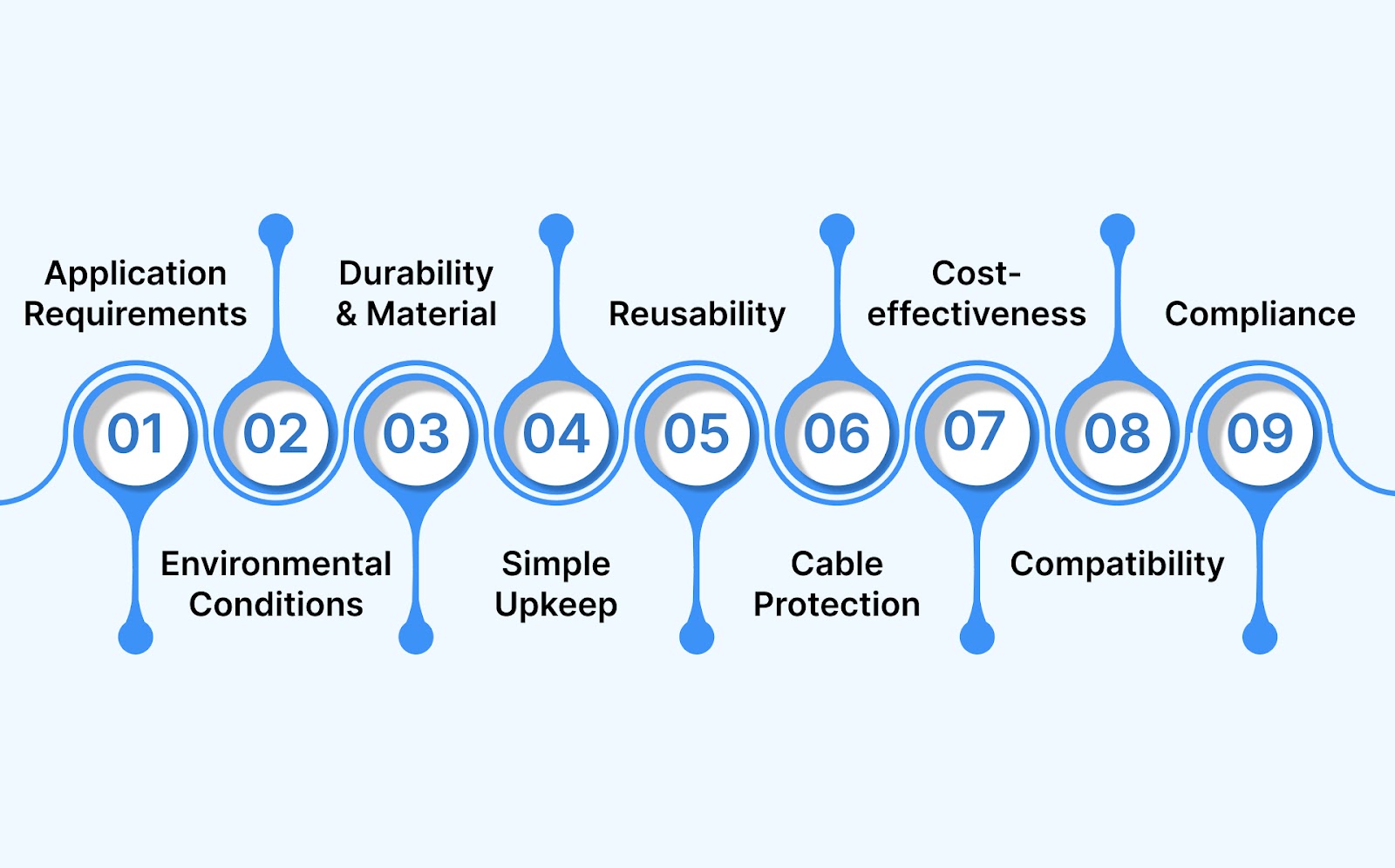
Selecting the right solar cable management solution is key to ensuring safety, durability, and efficiency. Consider the following factors to make the best choice for your specific installation.
- Application Requirements: Match the solution to the type of solar installation and cable specifications.
- Environmental Conditions: Factor in exposure to UV rays, temperature changes, moisture, and wind.
- Durability and Material: Choose materials that resist corrosion, wear, and UV degradation.
- Ease of Installation and Maintenance: Opt for solutions that simplify installation and allow easy inspection access.
- Reusability: Decide if reusable components are needed for flexibility or cost savings.
- Cable Protection: Ensure the solution prevents damage from sharp edges, abrasion, or mechanical stress.
- Cost-effectiveness: Balance upfront costs with long-term reliability and maintenance expenses.
- Compatibility: Confirm compatibility with cable types and solar panel mounting structures.
- Compliance: Verify that the products meet relevant industry standards and certifications.
Once you know how to choose, we’ll highlight best practices to optimize solar cable management.
Best Practices for Solar Cable Management
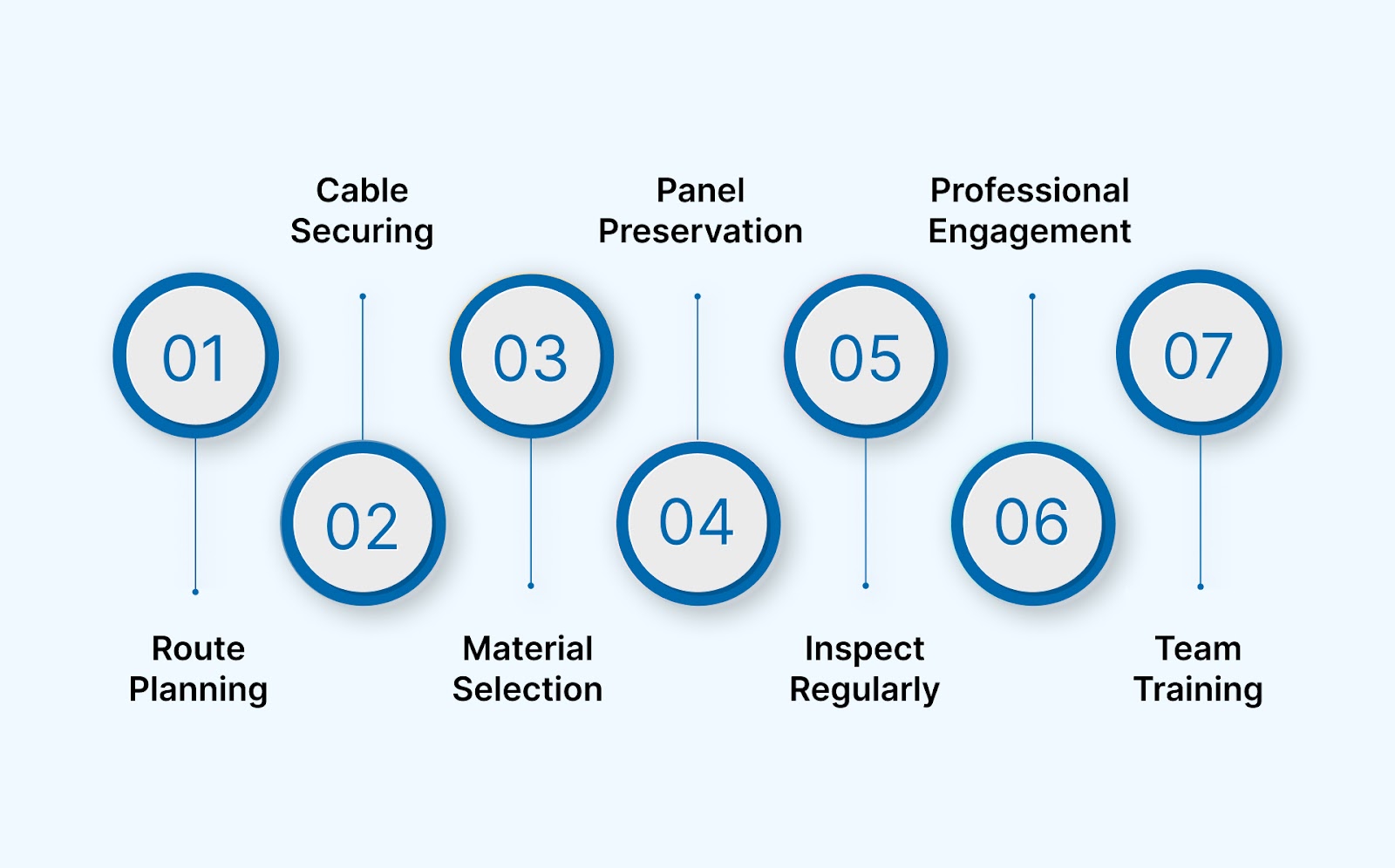
Proper cable management is crucial to maintaining solar installations' efficiency, safety, and durability. Applying the right practices ensures cables stay protected from environmental and mechanical damage, reducing maintenance costs and extending system life. Here’s a consolidated guide to effective solar cable management:
- Plan Cable Routing Carefully: Keep cables straight and avoid tight bends or oval shapes that can lead to premature wear or breakage. Thoughtful routing minimizes strain and supports smooth energy flow.
- Secure Cables Correctly: Use cable ties designed for the solar environment. Avoid fastening cables near sharp edges or metal surfaces unless properly shielded to prevent damage.
- Choose Durable Materials: Select UV-resistant and corrosion-resistant materials, such as stainless steel, that can withstand prolonged exposure to the sun, moisture, and temperature changes.
- Preserve Panel Integrity: Never drill into solar panels for cable attachment. Instead, use edge clips or mounts designed to secure cables without compromising panel structure.
- Inspect Regularly: Schedule routine checks to detect wear, corrosion, or loose fittings early. Timely maintenance helps prevent system failures and downtime.
- Engage Qualified Professionals: Entrust installation and maintenance to experts familiar with industry standards and solar-specific challenges to guarantee reliable performance.
- Train and Update Teams: Provide ongoing education about safe cable handling and emerging solar cable technologies, ensuring teams stay informed and practices remain current.
Implementing these best practices promotes a safer, more efficient, and longer-lasting solar setup while minimizing costly repairs and operational disruptions.
Conclusion
Effective solar cable management protects your system, boosts efficiency, and extends its lifespan. Choosing the right cable management solution helps prevent damage and simplifies maintenance.
Surelock offers durable, UV-resistant cable ties and accessories built for solar applications. Our products are designed to withstand harsh environments and support reliable, long-lasting solar installations.
Explore our solar cable management solutions and secure your system with confidence today. Request free samples now!



